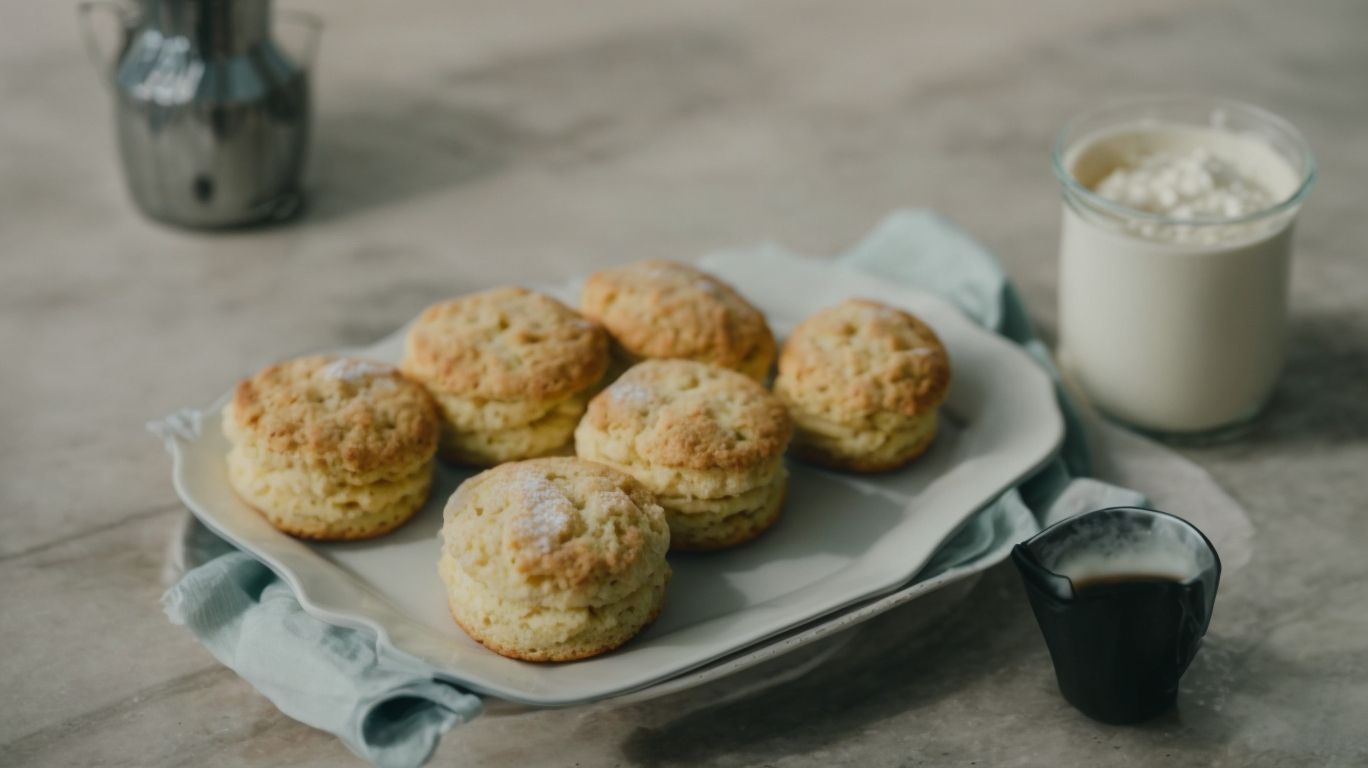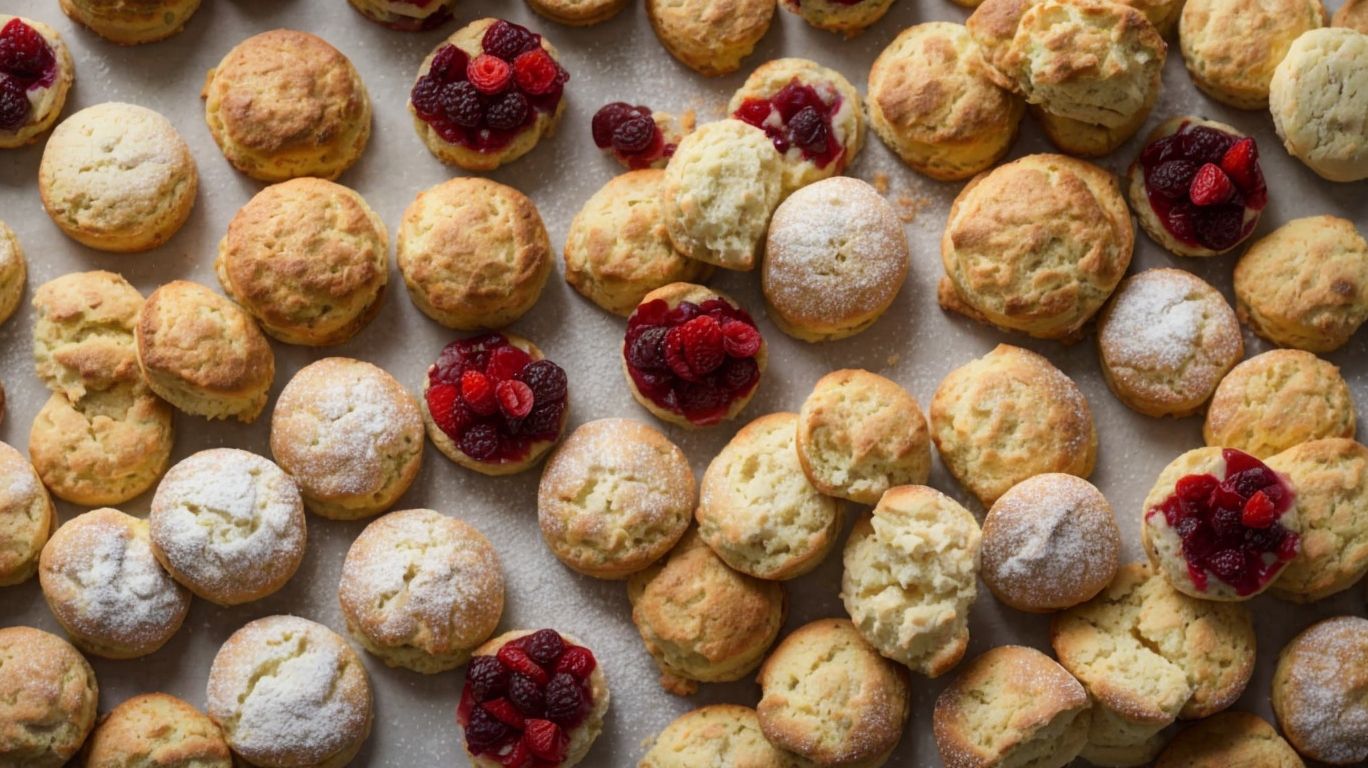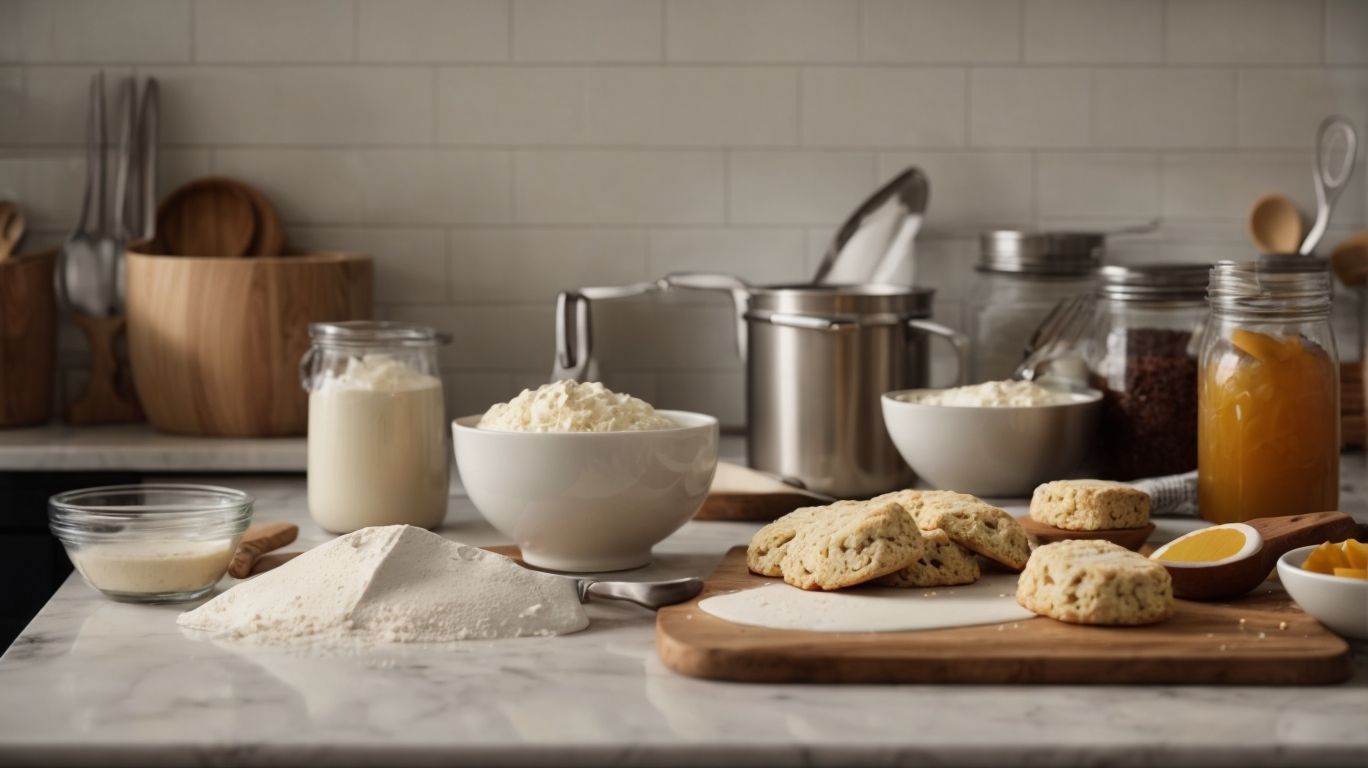How to Bake Scones With Cake Flour?
Looking to elevate your baking game? Explore baking with Chris Poormet and delve into the magic of cake flour. Discover the difference between cake flour and all-purpose flour, learn about scones, and find out the essential ingredients needed. Follow step-by-step instructions to make perfect scones and try delicious variations. Impress friends and family with your baking skills!
Key Takeaways:
Who is Chris Poormet?
Chris Poormet, the accomplished Culinary Blogger of the Year and former chef known for exquisite food photography, is the creative mind behind Poormet.com, a popular blog showcasing delectable recipes and culinary tips.
With a passion for visually stunning culinary creations, Chris Poormet has garnered numerous accolades for his impeccable skills in merging art and food. His keen eye for detail and unique style have set him apart in the world of food photography and recipe creation. Through Poormet.com, Chris shares his expertise, providing readers with not only mouthwatering recipes but also insightful cooking techniques and trends.
What is Cake Flour?

Credits: Poormet.Com – Charles Rivera
Cake flour is a finely milled soft wheat flour ideal for baking delicate cakes and pastries, providing a lighter texture compared to all-purpose flour.
Cake flour has a lower protein content than all-purpose flour, which results in a more tender and delicate crumb in baked goods. Due to its fine texture, cake flour is excellent for creating light and fluffy cakes with a soft crumb structure.
Its ability to absorb moisture and fat efficiently makes it perfect for producing cakes that are moist and tender. It’s important to note that cake flour is not suitable for recipes that require a strong gluten structure, such as bread making.
What is the Difference Between Cake Flour and All-Purpose Flour?
The key difference between cake flour and all-purpose flour lies in their protein content, impacting the texture and crumb of baked goods.
Cake flour is finely milled from soft wheat with a lower protein content, typically around 8-10%, compared to all-purpose flour which ranges from 10-12% protein content. The lower protein level in cake flour results in baked goods that are tender, light, and delicate in texture.
On the other hand, all-purpose flour’s higher protein content gives baked goods more structure and chewiness. This makes it versatile for a wide range of recipes, from cakes to cookies to breads.
While cake flour is ideal for delicate cakes like sponge or chiffon cakes, all-purpose flour is better suited for recipes that require a bit more structure, like muffins or quick breads.
What are Scones?
Scones are delightful baked goods popular in British and American cuisine, known for their tender texture and versatile pairing options.
These delectable treats, originating from Scotland, have become a staple in afternoon tea culture, embodying a sense of warmth and comfort. The texture of scones is typically crumbly on the outside and soft on the inside, achieved through the method of rubbing cold butter into flour to create a flaky dough. These sweet or savory pastries are most commonly baked in the oven until golden brown, and their variations include classic flavors like plain, fruit-filled, cheese, or herb-infused scones, each offering a unique taste experience. Scones also hold a symbolic value, representing tradition and indulgence in both British and American households.
What Ingredients Do I Need to Bake Scones With Cake Flour?
To bake delectable scones with cake flour, you’ll need a few essential ingredients, including butter, heavy cream, demerara sugar, and baking powder.
Butter plays a crucial role in scones; it adds richness and tenderness to the texture, while heavy cream contributes to the moistness and helps bind all ingredients together.
- Demerara sugar brings a hint of caramel flavor and a subtle crunch to the scones, enhancing the sweetness without overpowering the delicate cake-like crumb.
- Baking powder is the leavening agent that gives the scones their characteristic rise and lightness.
What are the Measurements for the Ingredients?
For baking scones with cake flour, precise measurements of ingredients such as butter, heavy cream, and demerara sugar are crucial to ensure the perfect balance of flavors and textures.
Butter, typically measured in grams or ounces, provides the rich, buttery flavor that scones are known for, along with contributing to their tender crumb. Heavy cream, measured by volume or weight, adds moisture and richness, resulting in a soft, moist interior.
Demerara sugar, measured in precise amounts, brings a subtle sweetness and a slight crunch to the scone’s crust. Too little or too much of any of these ingredients can significantly alter the scone’s texture, making it either dry and crumbly or overly moist and dense.
How Do I Make Scones With Cake Flour?
Creating delectable scones with cake flour involves a series of steps, from preparing the dough to baking it to golden perfection.
One crucial step in the scone-making process is to ensure that the cake flour is properly sifted before mixing it with other ingredients. Sifting helps to aerate the flour, resulting in a lighter texture for the scones.
Once the flour is sifted, it is important to handle the dough gently and avoid overmixing. Overworking the dough can lead to tough scones, so a light touch is essential during this stage.
After the dough is formed, it is typically shaped into rounds or triangles before being placed on a baking sheet. This shaping step not only adds to the visual appeal of the scones but also helps with even baking.
Step 1: Preheat the Oven
The first step in baking delicious scones with cake flour is to preheat the oven to the specified temperature, ensuring an ideal baking environment for the perfect scone texture.
Preheating is a crucial part of scone baking as it helps set the stage for the dough to rise properly and create that sought-after flaky texture. The recommended temperature for baking scones is usually around 400°F (200°C) to 425°F (220°C) to ensure even cooking and browning. It’s important to give the oven plenty of time to reach this temperature consistently, typically about 15-20 minutes.
The baking conditions play a significant role in achieving that perfect scone. Placing the scones on a baking sheet lined with parchment paper or a Silpat mat allows for even heat distribution and prevents sticking. Ensuring enough space between each scone on the baking sheet promotes uniform baking and golden crust formation.
Step 2: Mix the Dry Ingredients
Next, combine the dry ingredients such as cake flour and baking powder in a mixing bowl, ensuring even distribution and uniform texture in the scone dough.
It’s crucial to sift the dry ingredients together to avoid clumps and ensure a smooth consistency in the dough. The cake flour contributes to the scones’ tender crumb, while the baking powder provides the necessary lift during baking.
Once the dry ingredients are in the bowl, use a whisk or fork to blend them thoroughly. This step helps evenly distribute the leavening agents and other components for balanced flavor and texture throughout the scones. Be mindful not to overmix, as this can result in tough scones with an undesirable density.
Step 3: Cut in the Butter
Cutting in the butter is a crucial step in scone preparation, as it creates flaky layers and adds richness to the dough, enhancing the overall flavor and texture.
When cutting in the butter, the goal is to evenly distribute small pieces of cold butter throughout the dry ingredients. This process requires a delicate balance of incorporating the butter without overworking the dough, as this can result in tough scones.
The technique helps to create pockets of butter within the dough that melt during baking, producing steam that lifts the layers and contributes to the scone’s flakiness. The combination of butter fat and flour forms a barrier that prevents gluten development, resulting in a tender, crumbly texture that is characteristic of a well-made scone.
Step 4: Add the Wet Ingredients
Incorporate the wet ingredients like heavy cream into the scone mixture, carefully blending to achieve a moist and tender scone dough ready for shaping.
When adding the heavy cream or any other wet ingredient, it is crucial to pour it gradually while mixing the dough with a light hand. This gradual addition helps in controlling the moisture level of the dough, ensuring it doesn’t become too wet or sticky. The key is to reach a consistency where the dough holds together without being overly wet, allowing you to pat it into a cohesive mass.
Through gentle folding and mixing motions, ensure that the wet ingredients are evenly distributed without overmixing. Overworking the dough can lead to tough scones instead of the desired delicate crumb. The goal is to blend the wet ingredients until just combined, with all ingredients fully hydrated for a uniform texture.
Step 5: Shape and Cut the Dough
Shape the scone dough into desired forms and cut them into portions before baking, ensuring uniform size and consistent baking results.
To achieve consistent results when shaping scone dough, it is recommended to gently pat the dough into a uniform thickness before cutting. This ensures even baking and prevents unevenly cooked scones. Portioning the dough with a sharp knife or pastry cutter helps maintain symmetry and uniformity in size, promoting both aesthetic appeal and even baking.
When forming the scones, consider creating neat edges by patting the sides gently to define the shape. This attention to detail enhances the overall presentation of the baked scones, making them visually appealing and appetizing.
Step 6: Bake the Scones
Place the shaped scones on a baking sheet and bake them in the oven until golden brown, achieving a crisp exterior and moist, fluffy interior.
To ensure the perfect scone, preheat your oven to 400°F (200°C) for that ideal balance of browning and rise. It’s essential to handle the dough lightly and not overmix it to maintain the desired flakiness. For a moist texture, consider adding a tablespoon of buttermilk or cream to the mix.
- For a soft crust, brush the tops of the scones with a mixture of melted butter and egg wash before baking.
- Remember to bake the scones on the middle rack of the oven for even heat distribution.
What Are Some Tips for Baking Perfect Scones?

Credits: Poormet.Com – Zachary White
To ensure your scones turn out perfectly every time, follow these expert tips that guarantee a moist, tender interior and a crisp, golden exterior.
Begin by using cold ingredients when making your scone dough; this helps maintain the butter’s integrity, crucial for achieving that sought-after flakiness.
Handling the dough gently
is key to avoid over-mixing, which can result in tough scones. Once the dough is formed, consider using a sharp cutter rather than twisting to cut out the shapes. This ensures a clean edge, allowing the scones to rise evenly. To further boost the flavor profile, experiment with adding dried fruits, nuts, or even a hint of
citrus zest
to the mix.
What Are Some Variations of Scones I Can Make With Cake Flour?

Credits: Poormet.Com – Wayne Adams
Explore the delightful world of scone variations using cake flour, from zesty blueberry lemon to indulgent chocolate chip, offering a range of creative options for your baking endeavors.
Indulge in the burst of vibrant flavors with the blueberry lemon scones, where tangy blueberries perfectly complement the fresh citrusy notes of lemon zest, creating a harmonious combination in every bite.
Switching gears to the chocolate chip scones, savor the richness of dark chocolate morsels dotted throughout, adding a decadent touch to the classic scone texture.
For a more refreshing twist, try the cranberry orange scones featuring the perfect balance of tart cranberries and zesty orange zest, providing a delightful contrast of flavors.
Delve into the warm and comforting world of cinnamon raisin scones, where the aromatic cinnamon swirls mingle flawlessly with the sweet plump raisins, delivering a cozy and aromatic treat.
Blueberry Lemon Scones
Blueberry lemon scones offer a burst of citrusy freshness combined with juicy blueberries, creating a harmonious blend of flavors in every delightful bite.
These delectable pastries are known for their vibrant colors, with the deep purple of the blueberries contrasting beautifully with the bright yellow zest of the lemon. The tangy lemon flavor cuts through the sweetness of the blueberries, resulting in a balanced treat that is perfect for breakfast, brunch, or a relaxing afternoon snack.
Regarding baking blueberry lemon scones, the key lies in using fresh, high-quality ingredients. The buttery richness of the scone dough provides a perfect base for the bursts of fruity flavors, while a sprinkle of sugar on top adds a delightful crunch to every bite.
Chocolate Chip Scones
Indulge in the richness of chocolate chip scones, where the buttery crumb meets decadent chocolate morsels for a delightful twist on a classic favorite.
The marriage of the buttery texture of a well-baked scone with the bursts of chocolate sweetness creates a symphony of flavors that dance on your taste buds with each bite. The interplay of the warm, slightly crisp exterior and the soft, moist interior elevates the sensory experience to new heights. The incorporation of creamy chocolate chips adds a luscious dimension to the scone, making it a treat that is hard to resist. Whether enjoyed with a cup of tea in the afternoon or savored as a sweet breakfast indulgence, chocolate chip scones are a versatile delight for any time of day.
Cranberry Orange Scones
Tangy cranberries and zesty orange zest unite in cranberry orange scones, offering a delightful balance of sweet and citrusy flavors in every bite.
These scones are a true treat for the taste buds, with the cranberries providing a burst of tartness that complements the bright, fragrant notes of the orange zest perfectly. The dough itself is rich and buttery, creating a tender crumb that melts in your mouth. Each bite is a symphony of flavors and textures – the slightly crisp exterior giving way to a soft, moist interior dotted with juicy cranberries.
Cinnamon Raisin Scones
Warm spices and plump raisins define the comforting allure of cinnamon raisin scones, offering a cozy and flavorful treat for any time of day.
These delightful scones boast a captivating aroma that fills the kitchen as they bake to golden perfection. The cinnamon infuses each bite with a warmth that tingles the taste buds, complemented by the bursts of sweetness from the plump raisins. Crafted with the perfect balance of sweetness and spice, these scones are a delightful snack or accompaniment to a steaming cup of tea or coffee.
The use of high-quality ingredients, such as cake flour, elevates the texture to a tender crumb that practically melts in your mouth. These scones, with their slight crispness on the edges and soft center, are a true testament to the art of baking.
Frequently Asked Questions
What is the difference between scones and cake?
Scones are a type of quick bread traditionally made with flour, baking powder, butter, and milk, while cake is a sweet dessert typically made with flour, sugar, eggs, and butter. However, when using cake flour to bake scones, the texture and taste can resemble that of a cake.
Why use cake flour for scones?
Cake flour has a lower protein content than all-purpose flour, which results in a lighter and more tender texture. This makes it an ideal choice for baking scones, as they should have a delicate crumb and not be too dense.
Can I substitute cake flour with all-purpose flour?
Yes, you can substitute cake flour with all-purpose flour, but keep in mind that the texture and taste of the scones may be slightly different. All-purpose flour has a higher protein content, so the scones may be a bit denser and not as tender.
How do I properly measure cake flour for scones?
To properly measure cake flour, spoon it into a measuring cup and level it off with a straight edge. Do not pack the flour or shake the cup, as this can result in using too much flour and altering the texture of the scones.
Can I use self-rising cake flour to bake scones?
No, it is not recommended to use self-rising cake flour for scones. This type of flour already contains leavening agents, such as baking powder, which can affect the rise and texture of the scones.
What are some tips for baking scones with cake flour?
Some tips for baking scones with cake flour include using cold butter, handling the dough as little as possible, and not overmixing the ingredients. Additionally, make sure to preheat your oven and use a baking sheet lined with parchment paper for best results.

